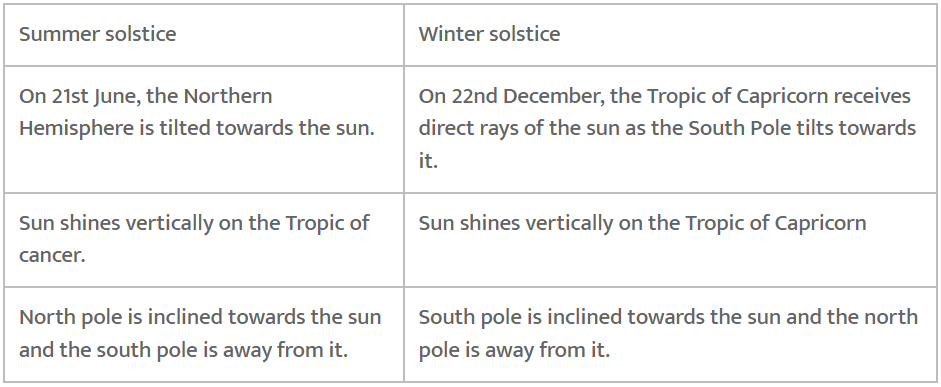Practice Questions: Motions of the Earth | Practice Questions with Solutions for Class 6 PDF Download
Q1: What causes day and night?
Ans: Rotation.
Q2: What is circle of illumination?
Ans: The circle of illumination is the division between day and night over the earth.
Q3: On 21st march and 23rd September, the sun rays fall directly on ________.
Ans: the equator.
Q4: The vernal equinox is commonly called _________.
Ans: Summer.
Q5: Name the angle of tilt of the earth.
Ans: The tilt of the Earth's axis is called obliquity.
Q6: Why do areas near the poles receive less heat?
Ans: The areas near the poles receive less heat as the rays of sun are slanting.
Q7: What do you mean by equinox?
Ans: On 23rd September, neither of the poles is tilted towards the Sun. This is called an equinox.
Q8: The Arctic Circle experiences day light continuously for ________.
Ans: 6 months.
Q9: Christmas in New Zealand is celebrated in ________.
Ans: Summer.
Q10: Why our shadow seems to be long in the morning and evening but short in noon?
Ans: The shadows are long in the morning and evening and short at noon. It is the effect of slanting and direct rays of the sun. When the rays of the sun are overhead in afternoon, the shadow is shortest. The rays of the sun are slanting during evening and morning hence the shadows are long.
Q11: What do you understand by polar day and polar night?
Ans: The polar night occurs when the night lasts for more than 24 hours. This only occurs inside the polar circles. The opposite phenomenon, when the sun stays above the horizon for a long time is called the polar day or midnight sun.
Q12: Why do the poles experience about six months day and six month night?
Ans: The axis of the earth remains inclined permanently in the same position. Because of this reason the sun continuously either shines or cannot be visible for a long time near the poles. The earth rotates causing day and night at other places but remain either dark or lighted for much longer time due to the tilt. Due to this reason, the areas near the poles experience six months day and six months night.
Q13: Why both hemispheres experience different winter and summer solstice?
Ans: During May, June and July, the northern hemisphere is exposed to more direct sunlight because the hemisphere faces the sun. The same is true of the southern hemisphere in November, December and January. This is due to the tilt of the Earth. So June, July and August are the hottest months in the northern hemisphere and December, January and February are the hottest months in the southern hemisphere.
Q14: What is a leap year?
Ans: The earth takes 365¼ days (one year ) to revolve around the sun. We consider a year as consisting of 365 days only and ignore six hours for convenience. These six hours saved every year are added to make one day i.e. 24 hours over a span of four years. This surplus day is added to the month of February. Thus, every fourth year, February is of 29 days instead of 28 days. Such a year with 366 days is called a leap year.
Q15: How is the rotation of the Earth responsible for causing day and night?
Ans: The Earth rotates on its axis from West to East and completes it in 24 hours. When the Earth rotates, the half portion facing the sun causes day and the other half remains in darkness causing night. Thus, day and night is a continuous phenomenon because of the rotation.
Q16: Why the southern hemisphere celebrates Christmas in summers?
Ans: On 22nd December, the Tropic of Capricorn receives direct sun rays due to the tilt of South Pole towards it. As the sun rays are vertical on it, hence it has summers. Therefore, Christmas which falls on 25th December is celebrated in summers in the Southern hemisphere.
Q17: What are the effects of the earth's revolution?
Ans:
- The phenomenon of seasons is caused.
- It causes variation in the length of day and night.
- It also causes variation in the distribution of heat over the surface of the earth.
Q18: What do you understand by the term autumn equinox?
Ans: On September 22nd or 23rd in the northern hemisphere, when night and day are nearly of the same length and Sun crosses the equator moving southward. And in the southern hemisphere on 20th or 21st March, Sun crosses the equator moving northward it is known as autumn equinox.
Q19: What is winter Solstice?
Ans: The position of the earth when it is winter season in Northern Hemisphere and summer season in Southern Hemisphere is called Winter Solstice.
Q20: Distinguish between summer solstice and winter solstice?
Ans:















